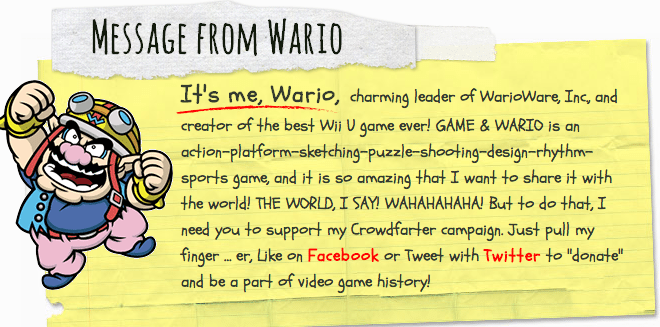To paint the perfect landscape, you might need to get up early and take a long hike. Whether you’ve gotten a commission or you’re just keeping it for yourself, you’ll want to find the perfect spot to capture a Sunset Over Water.
What Is Sunset Over Water?
Sunset Over Water is a game about hiking and painting landscapes for 1 to 4 players. It’s currently seeking funding on Kickstarter, with a pledge level of $19 (plus shipping) for a copy of the game. The game involves some set collection and movement on a grid. Younger players could certainly learn to play since the rules aren’t too complex and there’s nothing inappropriate, though there can be a bit of “take that” depending on who’s playing.
New to Kickstarter? Check out our crowdfunding primer, and visit our Kickstarter curated page for more projects we love.

Sunset Over Water Components
Note: My review is based on a pre-production prototype, so final components may change from what’s pictured here, though much of the artwork itself is final. The icons on the landscape cards will be larger and more visible.
Here’s what’s included in the box:
- 60 Landscape Cards
- 30 Commission cards
- 7 Daily Goal cards
- 32 Planning cards (8 per player)
- 4 Artist tokens
- 10 Solo Variant cards
- 4 Reference cards
Most of the game consists of cards, and I imagine that the final component quality will be comparable to Herbaceous, which was also published by the Pencil First Games from the same design team.

The artwork is by Beth Sobel, who has also illustrated Herbaceous (among other things), and her landscape paintings are so detailed that it’s almost hard to believe that they’re illustrations and not just photographs until you look more closely.
The cards, for the most part, are all pretty self-explanatory, and the reference cards are suitably helpful, explaining the turn order. The planning cards, which range from 5:00 to 12:45, indicate what time you “wake up” in the morning and will determine player order. Each player gets 8 cards, and the times are set at different quarter-hours, so that one player will have 5:15 and another will have 5:45, but nobody has the exact same times so there’s never a tie.
The Artist tokens are little wooden meeples that look like an artist sitting with sketchbook; I like that the four artists have slightly different hats and hair silhouettes.

The solo variant includes:
- 4 Ranger Station cards
- 5 Inspiration cards
- 1 Solo Journal card
I’ll explain these components more in the rules section, but the Ranger Station has a full-card illustration of a ranger station on one side, and a cropped version of the illustration with a gameplay reminder on the other.
How to Play Sunset Over Water
The Goal
The goal of the game is to score the most points through commissions and daily goals after six “days” of hiking and painting.
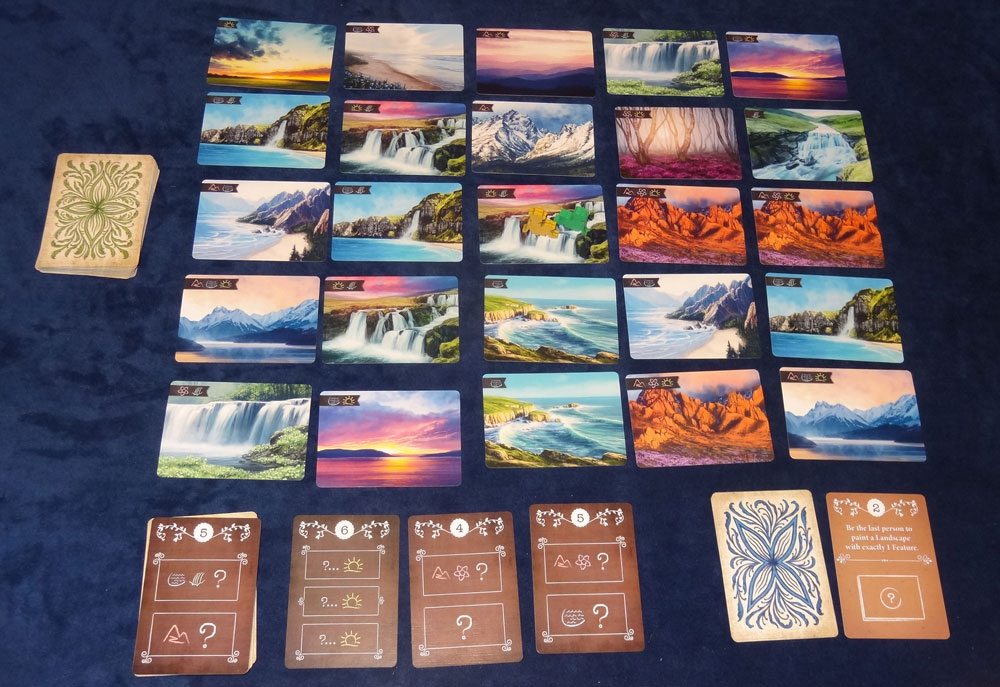
Setup
Give each player a set of planning cards and a meeple. Shuffle the landscape cards and lay out a 5×5 grid face-up. Place all the meeples on the center card. Shuffle the commission cards and place one more card than the number of players face-up near the grid, and then turn the top card of the deck face-up. (Note: the face-up top card is a rule that I find easy to forget.) Shuffle the daily goal cards and place one face-up next to the deck.
Gameplay
The game will consist of 6 rounds, and each round has three phases: Planning, Trek, and Clean Up.

Planning
At the start of your game, shuffle your planning cards to form a deck. During the planning phase, draw the top three cards, and choose one to play, and then return the other two to the bottom of your deck. The time on the planning card indicates how early you woke up that day, and determines the player order for that day.
Trek
This phase is the bulk of your turn. When it comes to your turn order, you’ll get to move, paint, sell, and claim a daily goal. First, you move your pawn on the grid of cards: your planning card shows you the maximum number of spaces you may move, and in which directions. You may pass through spaces with other artists in them, but you may not end your movement there. You may not pass through spaces that do not have cards.
To paint, you may pick up landscape cards that you have traveled through this turn, including the cards that you start and end your turn on, though not if they have other artists on them. Your planning card shows you how many landscape cards you may pick up. Your paintings are placed face-up in front of you.

To sell, you’ll need to discard paintings that match one of the available commission cards. (The face-up card on top of the deck is not available and is just there for planning purposes.) Each commission card shows one to three boxes, each with some number of symbols in them. You must discard one painting for box, and the features on your paintings must match the symbols on the commission cards, with one symbol for each “?” shown. The “?…” symbol (as seen on the upper right) means any number of symbols (including zero), so to fulfill that commission you just need three paintings with coasts, either with or without other features. If you sell paintings, take the commission cards and put them in your own score pile.
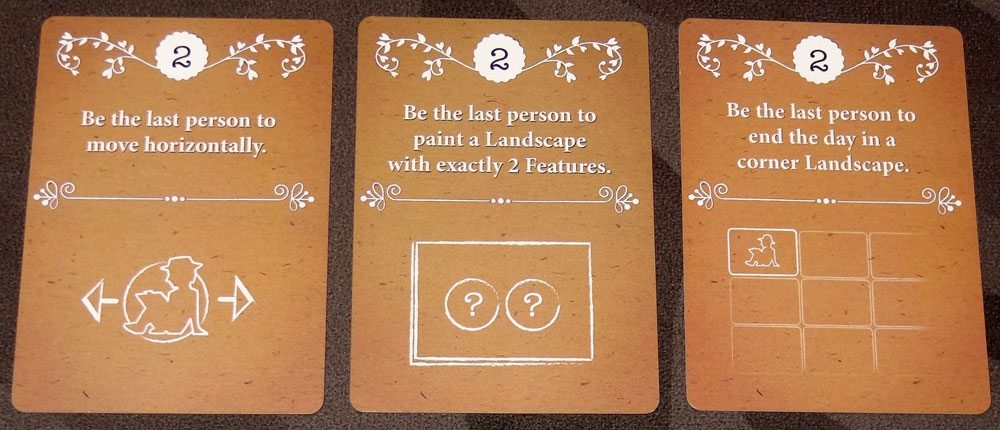
Each day, there is one daily goal card displayed, which will award 2 points to the last player who fulfills the card’s requirements. You may need to move in a particular direction, paint a particular type of painting, or not sell any paintings at all. If you meet the goal, take the daily goal card–but if somebody else meets the goal after you that day, they take the card from you. If you have it at the end of the day, you may put it into your score pile.
Clean Up
After everyone has taken a turn, you refresh everything for the following day. Refill any holes in the landscape grid, refill the commission cards (and turn the top card face-up), and draw a new daily goal (discarding the previous one if it was not met).
Game End
The game ends after 6 days–players will not have 3 planning cards to draw. Your score is the total of:
- Commission cards
- Daily goal cards
- 1 point per 2 features on unsold paintings
The highest score wins, with ties broken by number of of daily goals, and then number of commission cards.
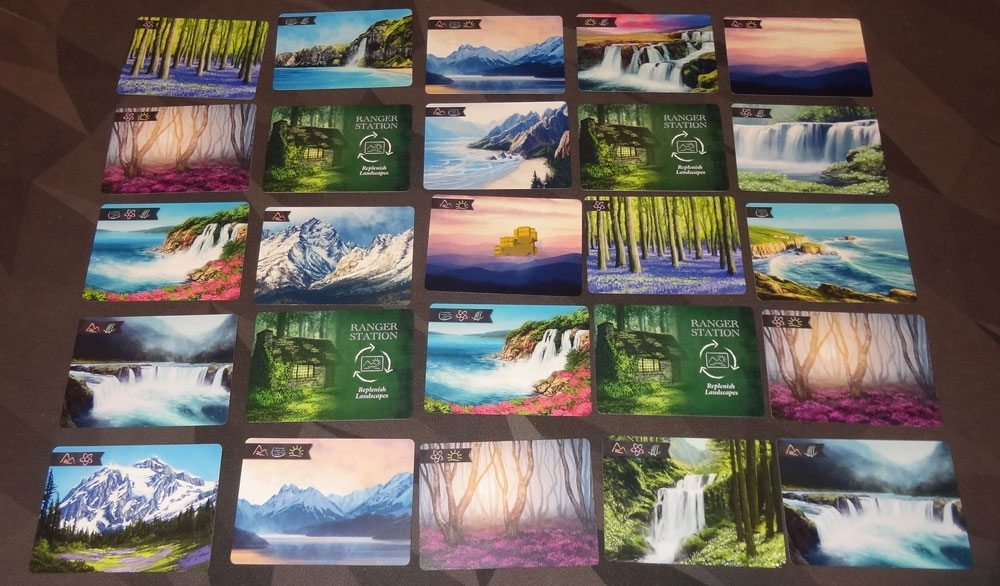
Solo Variant
For the solo variant, you’ll set up the landscape grid but replace the four spaces diagonally adjacent to the center with the ranger station cards. Deal 3 commission cards out, and turn the top card face-up. The daily goal cards aren’t used. Place the solo journal card in front of you, and randomly draw one of the inspiration cards and place it face-up.
You’ll play 8 days instead of 6: each time you pick a planning card, instead of discarding the other two, you keep them, and you’ll draw a new one for the next day. You’ll play until you run out of all of the planning cards.
On each turn, play the planning card onto the solo journal, and then take the action associated with the time chosen:
- Early Morning (5:00 to 7:45): Replenish all empty landscape spaces.
- Mid Morning (8:00 to 10:45): Discard the highest-value commission card and do not replace it.
- Late Morning (11: to 12:45): Discard the 2 highest-value commission cards and do not replace.
Every time you move onto or through a ranger station, you immediately replenish landscape spaces surrounding that ranger station. You may not paint a ranger station. You do not refill landscape spaces automatically during clean up.
In the final round, you may also claim the face-up commission card if possible.

At the end, you score points for renown and features on unsold paintings as usual. You also score 1 bonus point for each completed commission card that includes the feature shown on the inspiration card. You also score a “Return Home” bonus of 2 points if you end the game on the center space of the grid.
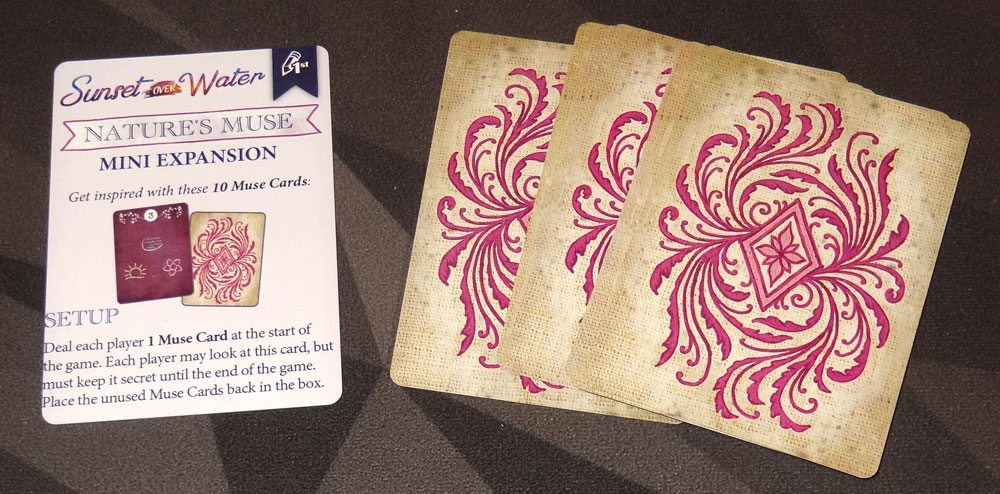
There’s a mini expansion for Kickstarter backers called Nature’s Muse that consists of 10 Muse cards. Each one shows a combination of three icons, and each player gets one card at the beginning of the game and keeps it secret.

At the end of the game, you count up the total number of times the symbols on your muse card appear on all of your collected commissions. Whoever has the highest total scores 3 bonus points. In case of a tie, tied players score 1 bonus point each instead. The Nature’s Muse expansion adds just a little bit more to the game and gives you some options to score a few points if you can’t sell commissions for a round, without changing up the core rules of the game.
Why You Should Play Sunset Over Water
I’m a fan of Herbaceous, the previous game created by the same team: designed by Steve Finn, illustrated by Beth Sobel, produced by Ed Baraf, and with a solo variant by Keith Matejka. It’s always fun to see games that include themes that don’t feel overdone. Although there have been some games about painting, Sunset Over Water mixes in the hiking mechanic, which adds some strategy in where to position yourself on the board.
Deciding how early to wake up is the first decision you’ll have to make each round. You’ll only have three of your planning cards to choose from, so sometimes you’ll have a bigger time range than others. But your cards also determine how far you can move, what direction, and how many paintings you can paint. If you’re really hoping to fulfill a big commission, you might be limited because only one of your cards lets you paint 3 landscapes. Or you might want to get up early but then realize that your early card only lets you move diagonally.
Of course, sometimes you just have bad luck. I’ve had rounds where I played my earliest card, only to find that everyone else was getting up between 5 and 6, making me last place even at 6:15. And other times, I resigned myself to being late, but then everyone else played late cards as well. If you use up your early cards at the beginning of the game, you won’t have any left toward the end.
Going first has its advantages: you can move before anyone else does, and you have the best opportunity to sell some paintings for commissions before anyone else gets to them. Since commissions aren’t refilled until the end of the round, going last might result in selling nothing at all.

The other thing about going early is that you can leave holes in somebody else’s path or end your movement in such a way that it blocks other players. It’s a tactic that reminds me a little of Tokaido–even though thematically it’s all about hiking and painting landscapes, in the game you’re basically elbowing and shoving your way through somebody else’s vista, forcing them to go paint somewhere else.
There’s a small consolation prize for sleeping in, though: the daily goal cards. Hey, sometimes an artist needs a little “me” time, something you do just for yourself and not because there’s a paying customer asking for it. If you go last, you generally have the best opportunity at getting a daily goal, assuming you can meet its requirements.
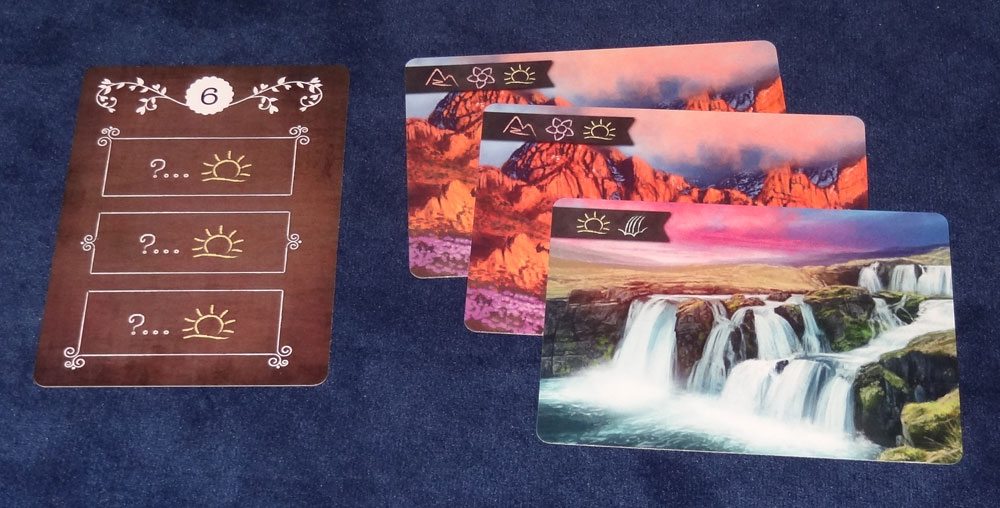
The primary goal for all of your planning and painting is the commission cards, of course, which are the biggest source of points. Each round, after planning cards are revealed, everyone works to figure out which path and which paintings will let them score the most valuable commissions, while also preventing other artists from claiming potentially valuable landscapes. It can get pretty cutthroat, depending on your group of players, but that makes it a lot of fun (in my opinion).
Overall, Sunset Over Water is a fun, fresh experience–it mixes some familiar mechanics in a new way, and the theme is also a refreshing change from many other tabletop games. It’s not a long game, so it makes a nice filler between larger games, or a good one for a shorter gaming session. Pencil First Games has now run and fulfilled several successful Kickstarter campaigns, so you can back with confidence that the finished product will turn out well.
For more information or to make a pledge, visit the Sunset Over Water Kickstarter page!
Click here to see all our tabletop game reviews.
Disclosure: GeekDad received a prototype copy of this game on loan for review purposes.




